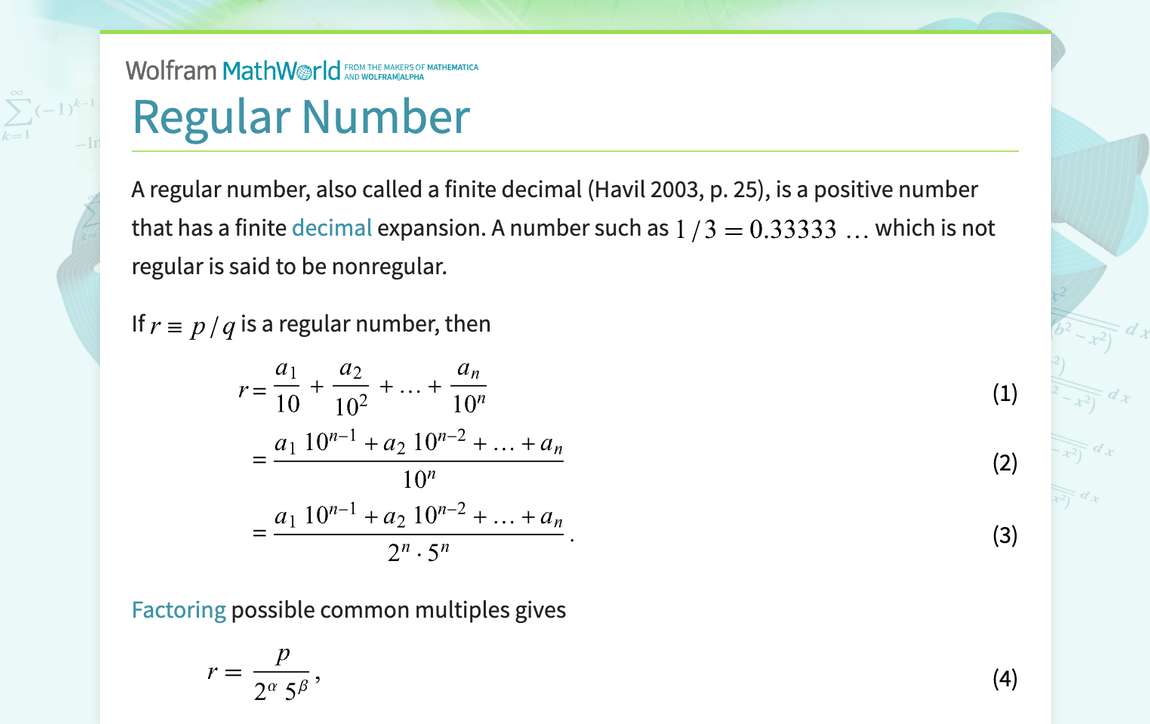
mathworld.wolfram.com/RegularNumber.html
Preview meta tags from the mathworld.wolfram.com website.
Linked Hostnames
6- 28 links tomathworld.wolfram.com
- 4 links towww.wolfram.com
- 4 links towww.wolframalpha.com
- 3 links towww.amazon.com
- 2 links tooeis.org
- 1 link towolframalpha.com
Thumbnail

Search Engine Appearance
Regular Number -- from Wolfram MathWorld
A regular number, also called a finite decimal (Havil 2003, p. 25), is a positive number that has a finite decimal expansion. A number such as 1/3=0.33333... which is not regular is said to be nonregular. If r=p/q is a regular number, then r = (a_1)/(10)+(a_2)/(10^2)+...+(a_n)/(10^n) (1) = (a_110^(n-1)+a_210^(n-2)+...+a_n)/(10^n) (2) = (a_110^(n-1)+a_210^(n-2)+...+a_n)/(2^n·5^n). (3) Factoring possible common multiples gives r=p/(2^alpha5^beta), (4) where p≢0 (mod 2, 5)....
Bing
Regular Number -- from Wolfram MathWorld
A regular number, also called a finite decimal (Havil 2003, p. 25), is a positive number that has a finite decimal expansion. A number such as 1/3=0.33333... which is not regular is said to be nonregular. If r=p/q is a regular number, then r = (a_1)/(10)+(a_2)/(10^2)+...+(a_n)/(10^n) (1) = (a_110^(n-1)+a_210^(n-2)+...+a_n)/(10^n) (2) = (a_110^(n-1)+a_210^(n-2)+...+a_n)/(2^n·5^n). (3) Factoring possible common multiples gives r=p/(2^alpha5^beta), (4) where p≢0 (mod 2, 5)....
DuckDuckGo
Regular Number -- from Wolfram MathWorld
A regular number, also called a finite decimal (Havil 2003, p. 25), is a positive number that has a finite decimal expansion. A number such as 1/3=0.33333... which is not regular is said to be nonregular. If r=p/q is a regular number, then r = (a_1)/(10)+(a_2)/(10^2)+...+(a_n)/(10^n) (1) = (a_110^(n-1)+a_210^(n-2)+...+a_n)/(10^n) (2) = (a_110^(n-1)+a_210^(n-2)+...+a_n)/(2^n·5^n). (3) Factoring possible common multiples gives r=p/(2^alpha5^beta), (4) where p≢0 (mod 2, 5)....
General Meta Tags
19- titleRegular Number -- from Wolfram MathWorld
- DC.TitleRegular Number
- DC.CreatorWeisstein, Eric W.
- DC.DescriptionA regular number, also called a finite decimal (Havil 2003, p. 25), is a positive number that has a finite decimal expansion. A number such as 1/3=0.33333... which is not regular is said to be nonregular. If r=p/q is a regular number, then r = (a_1)/(10)+(a_2)/(10^2)+...+(a_n)/(10^n) (1) = (a_110^(n-1)+a_210^(n-2)+...+a_n)/(10^n) (2) = (a_110^(n-1)+a_210^(n-2)+...+a_n)/(2^n·5^n). (3) Factoring possible common multiples gives r=p/(2^alpha5^beta), (4) where p≢0 (mod 2, 5)....
- descriptionA regular number, also called a finite decimal (Havil 2003, p. 25), is a positive number that has a finite decimal expansion. A number such as 1/3=0.33333... which is not regular is said to be nonregular. If r=p/q is a regular number, then r = (a_1)/(10)+(a_2)/(10^2)+...+(a_n)/(10^n) (1) = (a_110^(n-1)+a_210^(n-2)+...+a_n)/(10^n) (2) = (a_110^(n-1)+a_210^(n-2)+...+a_n)/(2^n·5^n). (3) Factoring possible common multiples gives r=p/(2^alpha5^beta), (4) where p≢0 (mod 2, 5)....
Open Graph Meta Tags
5- og:imagehttps://mathworld.wolfram.com/images/socialmedia/share/ogimage_RegularNumber.png
- og:urlhttps://mathworld.wolfram.com/RegularNumber.html
- og:typewebsite
- og:titleRegular Number -- from Wolfram MathWorld
- og:descriptionA regular number, also called a finite decimal (Havil 2003, p. 25), is a positive number that has a finite decimal expansion. A number such as 1/3=0.33333... which is not regular is said to be nonregular. If r=p/q is a regular number, then r = (a_1)/(10)+(a_2)/(10^2)+...+(a_n)/(10^n) (1) = (a_110^(n-1)+a_210^(n-2)+...+a_n)/(10^n) (2) = (a_110^(n-1)+a_210^(n-2)+...+a_n)/(2^n·5^n). (3) Factoring possible common multiples gives r=p/(2^alpha5^beta), (4) where p≢0 (mod 2, 5)....
Twitter Meta Tags
5- twitter:cardsummary_large_image
- twitter:site@WolframResearch
- twitter:titleRegular Number -- from Wolfram MathWorld
- twitter:descriptionA regular number, also called a finite decimal (Havil 2003, p. 25), is a positive number that has a finite decimal expansion. A number such as 1/3=0.33333... which is not regular is said to be nonregular. If r=p/q is a regular number, then r = (a_1)/(10)+(a_2)/(10^2)+...+(a_n)/(10^n) (1) = (a_110^(n-1)+a_210^(n-2)+...+a_n)/(10^n) (2) = (a_110^(n-1)+a_210^(n-2)+...+a_n)/(2^n·5^n). (3) Factoring possible common multiples gives r=p/(2^alpha5^beta), (4) where p≢0 (mod 2, 5)....
- twitter:image:srchttps://mathworld.wolfram.com/images/socialmedia/share/ogimage_RegularNumber.png
Link Tags
4- canonicalhttps://mathworld.wolfram.com/RegularNumber.html
- preload//www.wolframcdn.com/fonts/source-sans-pro/1.0/global.css
- stylesheet/css/styles.css
- stylesheet/common/js/c2c/1.0/WolframC2CGui.css.en
Links
42- http://oeis.org/A003592
- http://oeis.org/A117920
- http://www.amazon.com/exec/obidos/ASIN/0140080295/ref=nosim/ericstreasuretro
- http://www.amazon.com/exec/obidos/ASIN/0691099839/ref=nosim/ericstreasuretro
- http://www.wolframalpha.com/input/?i=number+bases